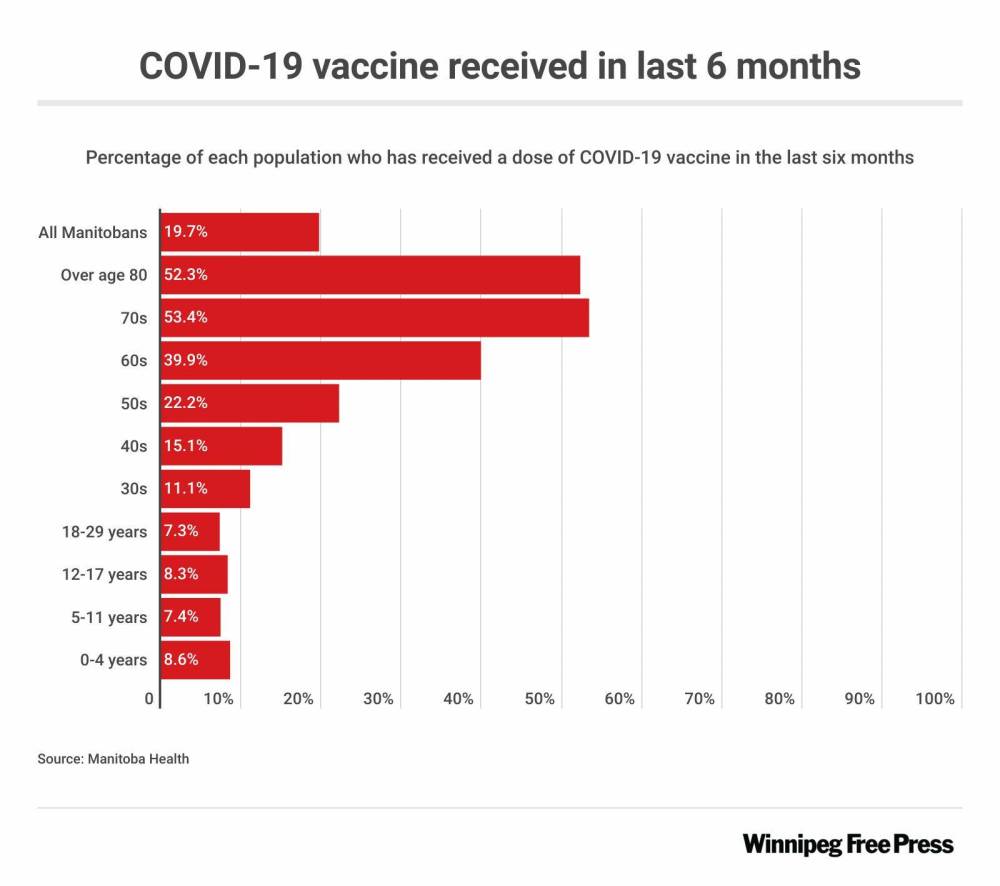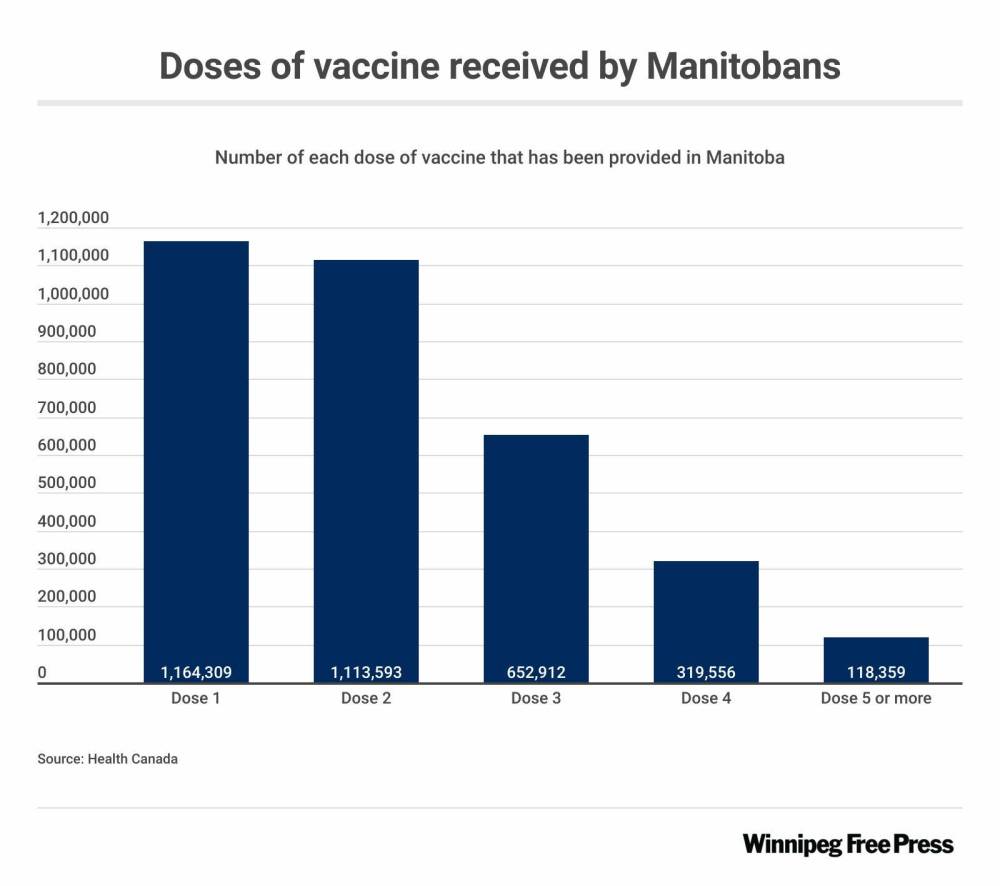Shot slump: COVID booster uptake waning in Manitoba
Advertisement
Read this article for free:
or
Already have an account? Log in here »
To continue reading, please subscribe:
Monthly Digital Subscription
$1 per week for 24 weeks*
- Enjoy unlimited reading on winnipegfreepress.com
- Read the E-Edition, our digital replica newspaper
- Access News Break, our award-winning app
- Play interactive puzzles
*Billed as $4.00 plus GST every four weeks. After 24 weeks, price increases to the regular rate of $19.00 plus GST every four weeks. Offer available to new and qualified returning subscribers only. Cancel any time.
Monthly Digital Subscription
$4.75/week*
- Enjoy unlimited reading on winnipegfreepress.com
- Read the E-Edition, our digital replica newspaper
- Access News Break, our award-winning app
- Play interactive puzzles
*Billed as $19 plus GST every four weeks. Cancel any time.
To continue reading, please subscribe:
Add Free Press access to your Brandon Sun subscription for only an additional
$1 for the first 4 weeks*
*Your next subscription payment will increase by $1.00 and you will be charged $16.99 plus GST for four weeks. After four weeks, your payment will increase to $23.99 plus GST every four weeks.
Read unlimited articles for free today:
or
Already have an account? Log in here »
Hey there, time traveller!
This article was published 23/03/2023 (945 days ago), so information in it may no longer be current.
Booster uptake is lagging amid a lack of information about current COVID-19 transmission, as many Manitobans manage reinfections or wait to become eligible for their next vaccination dose.
Roughly 20 per cent of Manitobans got a COVID-19 vaccine or booster in the past six months, provincial data shows. That number is in line with national trends, only slightly lower than overall vaccine uptake across the country.
About 22 per cent of Canadians received a dose in the past six months, according to Health Canada’s latest figures.
However, uptake appears to have dropped off among the oldest Canadians and didn’t quite take off for the youngest children.
Less than 10 per cent of babies and toddlers under five years old had at least one dose. About five per cent of that youngest age group received at least one dose in the past six months.
While close to all seniors received their first two doses of COVID-19 vaccines, far fewer followed up with additional boosters. More than 90 per cent of Canadians older than 60 completed their primary vaccine series, but uptake for those age groups in the past six months fell to between 40 to 55 per cent.
The biggest stumbling block could be the lack of necessity the public may perceive about COVID-19 boosters, said Ian Culbert, executive director of the Canadian Public Health Association.
After mandates were lifted and many people have already been infected with largely minor symptoms, the sense of urgency, Culbert said, “has absolutely waned over time.”
“As is often the case with vaccines, they do their job and then people forget why they had to take them in the first place.”
Spring boosters haven’t been recommended for the general population, many of whom would’ve received their most recent booster in fall 2022. A wider booster campaign is expected to come in the fall.
National recommendations advise it’s best to wait at least six months between booster doses or at least six months after a COVID infection for the best antibody response. Earlier this month, the National Advisory Committee on Immunization recommended high-risk Canadians get additional boosters this spring, including anyone over 80, people over 65 who have avoided getting infected so far, and any adults who are immunocompromised.
There’s more to lower vaccine uptake than complacency, said Michelle Driedger, a professor in University of Manitoba’s department of community health sciences and an expert in health risk communication.
The lack of transmission data muddles public messaging on COVID, leading to confusion, she said.
“We don’t have any real data on how many people have been affected with COVID and are recovering at home. So I think it’s kind of hard to put the 20 per cent in perspective — because we don’t know how much of that is a lack of interest in wanting to take on a booster or people who are just kind of managing things based on their own previous vaccine anniversary date, or most recent COVID infection.”
Manitoba will need to ramp up its vaccine communication and accessibility if the province plans to have a successful widespread booster campaign in the fall, Driedger said.
Such a campaign needs to explain why boosters still matter and make it convenient for people to get them, without assuming everyone has easy access to transportation, child care or flexibility to take time off work, she added.
“We have to really start addressing some of those outward barriers so that people aren’t being blamed if they’re not following what the recommended actions are.”
Federal funding is to expire next week for an online database dedicated to dispelling vaccine misinformation.
Funding through the Public Health Agency of Canada for the Canadian Vaccination Evidence Resource and Exchange Centre (also known as CanVax.ca) was only set to last until the end of this fiscal year. The public health association, which runs and hosts the website, doesn’t yet know if the funding will be renewed.
Combating misinformation and “completely unfounded” concerns about vaccine safety are still a big part of encouraging uptake, Culbert said. “Our hope is that there is kind of a bigger plan, because this issue isn’t going away.”
katie.may@winnipegfreepress.com

Katie May is a multimedia producer for the Free Press.
Our newsroom depends on a growing audience of readers to power our journalism. If you are not a paid reader, please consider becoming a subscriber.
Our newsroom depends on its audience of readers to power our journalism. Thank you for your support.





